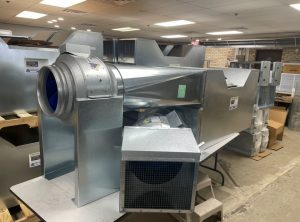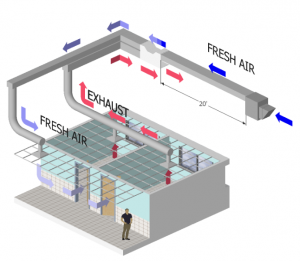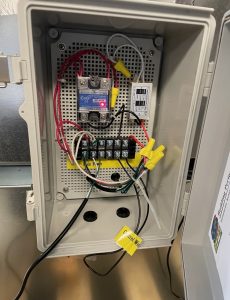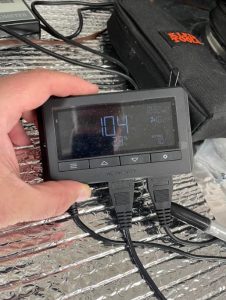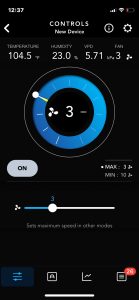Custom DOAS systems are more important now than ever!
Why include custom dedicated outdoor air system (DOAS) plans in your new construction or retrofit project? Because you’ll lessen health, financial, and climate issues in indoor spaces that may have felt like mere annoyances in the past. Collectively, we have a lot more riding on indoor air quality and energy efficiency these days—not to mention the growing climate threats of years ahead.
The HVAC challenges of today and tomorrow.
It all comes down to high-performance energy efficiency. If you’re in the building industry, it’s important to remember that the term ‘energy efficient’ often goes over laypeople’s heads. Sure, they know it’s a good thing, but many don’t understand how that efficiency can translate into indoor comfort, serious energy savings, stewardship toward the planet, and even health.
The size of a space and the nature of that space (Residential? Data Center? Dental office? Indoor Pool? Office? Hospital? Classroom? Garage? Salon?) dictate acceptable airflow. You’re going to spend more cooling a data center than you would in a small home. You need more air exchanges in a hair salon than for a small office. Likewise, emissions into the atmosphere are greater, and the energy bill grows. Building managers, faced with such bills, might choose to lower the energy spent on thermal comfort and indoor air quality in other areas to balance the budget. They might decide HVAC maintenance, including the simple replacement of filters, can wait.
We can’t afford to play the cutting corners game anymore. Covid is still out there and as the planet heats, it won’t be our last pandemic or epidemic rodeo. The planet is warming and good intentions over practical applications for change won’t cut it anymore. The quality of life in indoor spaces will require more energy in the future as climate change creates weather extremes.
You might want to remind those in the industry who show little concern for the future when considering new HVAC components that standards and codes will likely increase in the coming years. States are re-evaluating building codes, ASHRAE is at work on an IAQ Pathogen Mitigation Standard, there’s the EPA’s Clean Air Buildings Challenge, and organizations such as the Lancet Commission plan meetings of the minds to recommend change. Greater ventilation parameters create more energy use—unless you are employing high-performance equipment that reuses the energy burned by HVAC systems to optimize efficient energy use in your particular indoor spaces.
Flexible HVAC is essential.
A custom DOAS can ensure meeting the ventilation, health, and comfort needs of the right number of occupants, cater to unusual floor plans, accommodate the local climate, and offer building managers the opportunity to shift a portion of their energy budget to other needs. In short, it provides an indoor air solution that performs optimally under all conditions.
Build a DOAS system around a custom energy recovery solution.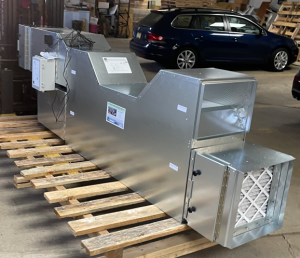
BPE High-performance Energy Recovery Ventilator DOAS systems enhance HVAC by providing optimal IAQ, thermal comfort, and energy efficiency with options that work specifically for your indoor environment needs.
We start with the energy recovery module itself, offering our patented, fixed plate, counter-flow units for a variety of space sizes, plus stackable modules for needs up to 20,000 cfm. Then there are our integral units that come with fans, filter boxes, controls, and louver box. Our product line can be purchased standard or customized in a variety of ways.
BPE Energy Recovery Modules always offer the following high-performance qualities:
- BPE units meet ANSI/ASHRAE Standard 62.1 2019 Ventilation for Acceptable Air Quality and can help new or retrofitted buildings meet LEED and ENERGYSTAR® requirements for various incentive programs.
- Prolongs life cycle of existing HVAC systems by reducing mechanical stress. Units can work with or separately from existing HVAC systems.
- BPE ERVs can boast a ROR of as little as 2 years.
- Up to 90%+ thermal efficiency
- No Cross Contamination of air streams
- Up to 34% latent effectiveness (humidity) via BPE Regenerative Condensate Return® Technology
- Energy Efficiency Ratings (EER) of 36 to 160 (industry standard is 10).
- Galvanized steel construction
Special Sensors
No amount of thorough air exchange and filtration will stop smoke from a fire indoors or right outside from recirculating throughout the HVAC system. That’s why BPE offers a built-in binary-point smoke sensor to prevent the ERV from drawing in more smoke by shutting it down.
Integral hydrogen gas sensors are available as well for areas where a mix of oxygen and too much hydrogen can become explosive. Upon sensing the issue, the unit would open to prevent sparking, then shut down.
ERV controls that work for your set-up.
The right variable speed controls are an important consideration when customizing your ERV system. When considering your options, think about who will be using them. Is fine tuning and programming the controls more likely to happen efficiently if they are housed on the ERV unit? Remotely from another location in the building? Will someone want to control them via Bluetooth® from home on their phone? BPE offers all those options.
Left to Right: Integral hard-wired controls; remote controls; Bluetooth®
Fun with (ERV) Fans.
To keep BPE units the most efficient, most ‘value for your money’ Energy Recovery Ventilators (ERVs) on the market, we keep an eye out for companies that complement our technology. While we love Fantech fans for our 3,000 cfm units on up, our smaller units typically come with AC Infinity’s Cloudline series fans. BPE XE modular units are ready to hook up to in-line fans. Our smallest unit, the BPE-XE-MIR-200i, comes with the fans built right in. The unitary commercial line offers fans boxes.
Left to Right: In-line fans; the BPE-XE-MIR-200i with fans built in; fan box on a unitary commercial ERV.
Energy Recovery Ventilator filters.
BPE units come standard with MERV 8 filters but may be ordered with up to MERV 13. Easy access filter slots or boxes make filter replacement a snap.
ERVs for frigid temperatures
BPE provides application assistance for adding an in-line heat pump to your ERV system for use in conditions below -10°F and/or 40% relative humidity. The compressor goes outside or on the roof next to the ERV and with the A-Coil set inside the air handler as follows.
Do your homework before choosing a DOAS system.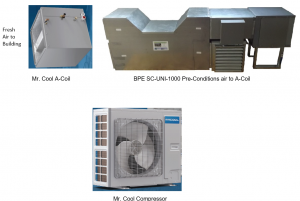
Unique indoor spaces need custom DOAS systems to reap the advantages of high-performance, energy-efficient ventilation and comfort. Always consult with a Local Mechanical Engineer comfortable with HVAC projects for on-site advice and ensuring your design meets local codes. And please, give us a call with any questions on our systems and how they can work for you!

